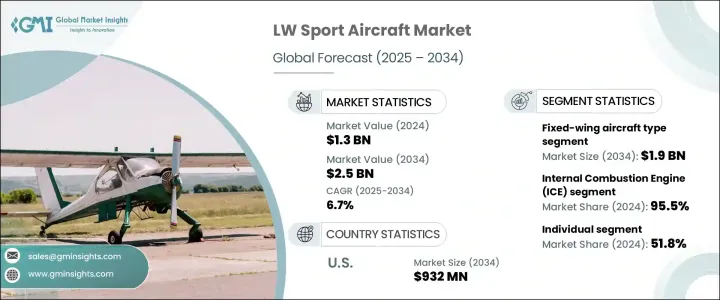
세계 경량 항공기 시장은 2024년에는 13억 달러로 평가되었고, 2034년에는 CAGR 6.7%로 성장하여 25억 달러에 이를 것으로 추정됩니다.
스포츠 비행에 참가자 증가, 비행 훈련 아카데미의 확대, 항공에 대한 소비자의 폭넓은 관심이 경량 항공기 수요를 가속화하고 있습니다.

경량 항공기 카테고리를 지원하는 규제의 갱신도 제조업자와 운항업체에게 유리한 환경을 만들어 내고 있습니다. 역풍에도 불구하고, 기술 혁신, 전동화, 렌탈이나 트레이닝의 이용 사례 증가에 의해 업계의 장기적 전망은 아직도 밝습니다.
| 시장 범위 | |
|---|---|
| 시작 연도 | 2024년 |
| 예측 연도 | 2025-2034년 |
| 시작 금액 | 13억 달러 |
| 예측 금액 | 25억 달러 |
| CAGR | 6.7% |
고정익 비행기 부문은 2034년까지 19억 달러에 달할 것으로 예측됩니다. 재료와 추진 시스템의 혁신이 이러한 성장을 뒷받침하고 있습니다. 경량 복합재와 하이브리드 전기 동력 시스템의 통합이 진행되어 항속 거리, 효율, 환경 성능이 향상되고 있습니다.
렌탈 사업자 부문은 소유에서 액세스로 이동하여 2034년까지 연평균 복합 성장률(CAGR) 9.1%로 성장할 것으로 예측됩니다. 많은 레크리에이션 플라이어는 구입 대신에 렌탈을 선택해, 렌탈 사업자는 보유체를 확대해, 파일럿 훈련 서비스를 제공하는 것으로 대응하고 있습니다. 특별 내공 증명의 근대화(MOSAIC) 이니셔티브와 같은 규제 발전은 운영자에게 더 큰 유연성을 제공하여 항공기 유형과 서비스 옵션을 확대할 수 있도록 합니다.
미국의 경량 항공기 시장은 2034년까지 9억 3,200만 달러에 이를 것으로 예측됩니다. 새로운 지침은 250노트 CAS의 더 높은 최대 속도, 접이식 랜딩 기어, 그리고 54노트로 증가된 실속 속도 제한을 허용하여 이러한 항공기가 설계되고 사용되는 방식을 변화시킬 것입니다.
세계 경량 항공기 시장의 주요 기업은 ICON Aircraft, Inc., PIPISTREL, Costruzioni Aeronautiche TECNAM SpA, CubCrafters, Flight Design general aviation GmbH 등입니다. 시장에서의 지위를 확보하기 위해 주요 기업은 기술 혁신과 규제에의 적응성에 중점을 두고 있습니다. 수많은 제조업체들은 비행 학교와 대여 회사와 전략적 파트너십을 맺고 판매 네트워크를 확대하고 있습니다.
The Global LW Sport Aircraft Market was valued at USD 1.3 billion in 2024 and is estimated to grow at a CAGR of 6.7% to reach USD 2.5 billion by 2034, driven by rising enthusiasm for recreational aviation, which is increasingly seen as an accessible and enjoyable leisure activity. Increased participation in sport flying, expansion of flight training academies, and broader consumer interest in aviation are accelerating demand for light sport aircraft. These aircraft are favored for their affordability, ease of handling, and minimal operating costs.

Regulatory updates supporting the light sport aircraft category have also created a favorable environment for manufacturers and operators. However, trade policies, especially tariffs on imported materials, have challenged production economics by disrupting supply chains and raising input costs. These factors have especially affected smaller OEMs, forcing strategic shifts in sourcing and international operations. Despite these headwinds, the industry's long-term outlook remains positive, thanks to technology innovation, electrification, and growth in rental and training use cases. With recreational flying expanding as a mainstream sport and more people seeking pilot training, LW sport aircraft are positioned as an essential part of the evolving general aviation ecosystem.
| Market Scope | |
|---|---|
| Start Year | 2024 |
| Forecast Year | 2025-2034 |
| Start Value | $1.3 Billion |
| Forecast Value | $2.5 Billion |
| CAGR | 6.7% |
The fixed-wing aircraft segment is expected to reach USD 1.9 billion by 2034. Demand for fixed-wing light sport aircraft continues to rise, especially among aviation schools and private pilots seeking efficient, low-maintenance aircraft. Innovations in materials and propulsion systems are supporting this growth. Lightweight composites and hybrid-electric power systems are increasingly integrated to improve range, efficiency, and environmental performance. These advancements are making fixed-wing models more attractive to new aviators and reducing overall ownership costs.
The rental operator segment is projected to grow at a CAGR of 9.1% through 2034, driven by the shift from ownership to access. Many recreational flyers opt for rentals instead of purchasing, and rental operators are responding by expanding their fleets and offering pilot training services. Regulatory developments, such as the Modernization of Special Airworthiness Certification (MOSAIC) initiative, offer operators greater flexibility in their offerings, enabling them to broaden aircraft types and service options.
United States LW Sport Aircraft Market is expected to reach USD 932 million by 2034. Regulatory reforms from the FAA, including speed and gear adjustments under MOSAIC, are reshaping the market. New guidelines that allow for a higher maximum speed of 250 knots CAS, retractable landing gear, and an increased stall speed limit of 54 knots are set to transform how these aircraft are designed and used. This regulatory shift encourages broader market participation, setting the stage for rapid expansion in North America.
Key players in the Global LW Sport Aircraft Market include ICON Aircraft, Inc., PIPISTREL, Costruzioni Aeronautiche TECNAM S.p.A., CubCrafters, and Flight Design general aviation GmbH. To secure their market position, leading companies focus on innovation and regulatory adaptability. Key strategies include developing aircraft that align with evolving FAA standards and increasing R&D to integrate electric and hybrid propulsion systems. Many manufacturers are also forming strategic partnerships with flight schools and rental companies to expand their distribution networks. Lightweight composite use is being scaled to boost aircraft performance and reduce emissions.